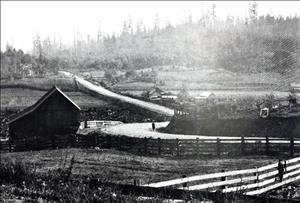On September 7, 1982, the King County Council adopts the Conservation Futures Tax to fund the county's Farmland Preservation Program. Proceeds from the Conservation Futures property tax can be used to acquire open space land, such as farmland, forests, and green space. The Farmland Preservation Program, approved by voters in 1979, has run into difficulty arranging funding due to legal issues, and the Conservation Futures tax offers a means to start acquiring conservation easements on farmland while other funding sources are developed. Over the ensuing decades, Conservation Futures revenue will also be used to acquire easements on, or outright ownership of, more than 100,000 acres of forests, farms, greenbelts, urban separators, riparian habitat, trail corridors, and urban green space.
In 1971, the state legislature passed a law authorizing counties to levy a small property tax (the rate varied by each county's existing tax burden and the rate chosen by county governments) to fund the acquisition of open space land. Alan Bluechel (b. 1924), a Republican representative from Kirkland, wrote the law, which answered criticisms of existing land use planning tools: zoning and current-use taxation. Zoning lacked permanency because it was subject to political processes and any property could be rezoned at any time. Current-use taxation, through which property was taxed at a lower rate if kept in an open space-compatible use, such as agriculture or forestry, also lacked permanency because property owners could remove their property from the program after 10 years (or sooner with payment of a penalty).
The Conservation Futures legislation allowed counties to purchase property outright or to acquire conservation easements on the land. These easements removed development rights from a parcel in perpetuity. Property owners voluntarily participated in the program and received financial compensation in addition to the lower tax rate assessed under the current-use taxation program.
Preserving Open Space
King County levied the first Conservation Futures tax in 1982, after adopting the program in order to fund the purchase of conservation easements on 2,100 acres of first priority land identified for the Farmland Preservation Program. King County voters had approved, in 1979, a $50 million bond issue for the purchase of development rights on farmland, which was rapidly succumbing to subdivisions. When, in 1980, the state Supreme Court upheld a challenge to the interest rate at which the bonds were to be issued, the council turned to different funding sources to carry out the program. One source was $15 million in councilmanic bonds, which are approved by the council rather than by voters, to be repaid in part with funds raised by the Conservation Futures property tax. Revenue from the Conservation Futures-backed bonds was used to protect farmland through the purchase of conservation easements.
In 1984, the county used revenue from the tax to purchase the first 2,000 acres of the Cougar Mountain Regional Wildlands Park. Conservation Futures revenue was then used to purchase land identified as part of an open space bond program approved by voters in 1989, after rising land prices pushed acquisition costs beyond the $117.6 million raised by the bond issue. In 1993, the county council issued $60 million in Conservation Futures-backed bonds to fund acquisition of additional open space lands.
The Council has continued the Conservation Futures program since the 1990s to fund acquisitions of a multitude of large and small parcels. Some urban green spaces cover less than a block; one purchase of conservation easements protected 90,000 acres in the Cascade foothills. Over time, the county has acquired easements over or ownership of greenbelts, neighborhood parks, riparian habitat, forests, trail corridors, green space between neighborhoods or for delineating urban areas from rural ones, shoreline access, and farmland.

